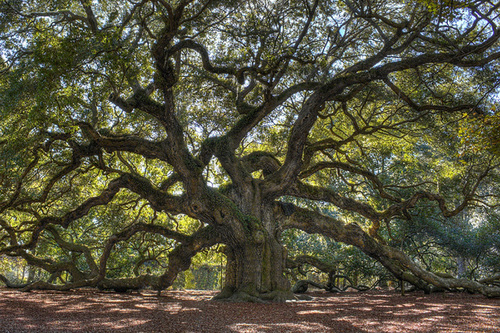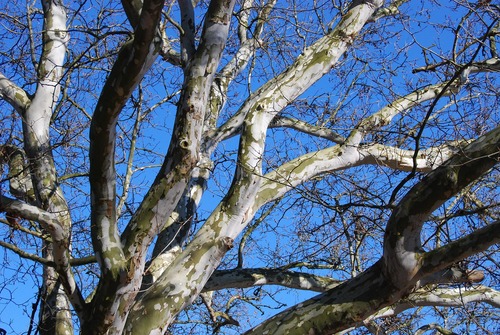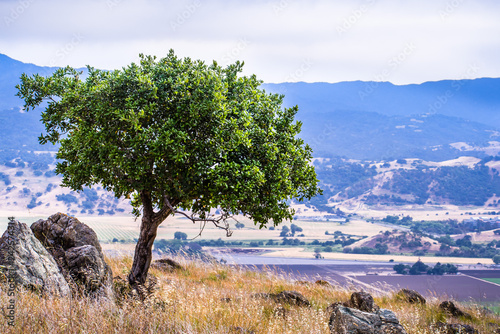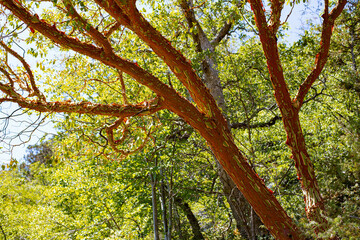11 Hardwood Trees for Windy Locations
Introduction
Strong winds can pose a serious threat to trees, turning even the mightiest of specimens into casualties of nature. Trees toppled by storms not only result in a dramatic, post-apocalyptic landscape but also leave a lasting impact on the ecosystem. Even trees that manage to stay upright often suffer from defoliation and broken branches, requiring years of recovery. However, some hardwood tree species have evolved to thrive in high-wind habitats, making them well-suited for windy landscapes and storm-prone areas. In this blog, we will explore eleven hardwood trees that are resilient against strong coastal winds in California. Additionally, we will discuss conifers and palms capable of withstanding windy conditions in a subsequent article.
Flowering Dogwood

A Leafy Tree Provides Shade for a Park Bench
Flowering Dogwood (Cornus florida) is an unexpected addition to our list due to its typical habitat in the sheltered understory of eastern forests. However, these trees possess remarkably hard, shock-resistant wood, allowing them to withstand high winds. It’s worth noting that flowering dogwoods have shallow root systems, making them susceptible to toppling in damp or compacted soils. Despite their small size, they are popular for their beautiful flowers, picturesque growth habit, and attractive fall colors. Their ability to tolerate strong winds further endears them to gardeners and homeowners.
Flowering dogwoods typically reach heights of twenty to thirty feet and are covered in stunning white or pink blossoms in the spring. These blossoms not only provide an aesthetic appeal but also serve as a valuable food source for various wildlife, including birds and insects. Their adaptability to windy conditions and their support of local ecosystems make them an excellent choice for gardens and residential areas prone to strong winds.
American Holly
American Holly (Ilex opaca) is another understory species that often successfully endures strong winds. These trees work well as ornamental or accent trees, especially during winter when their evergreen foliage adds aesthetic appeal. Their ability to withstand strong winds makes them excellent choices for screening purposes. Columnar-shaped cultivars, such as the ‘Slim Jim’ American holly , are particularly valuable for this application.
American holly, with its vibrant red berries and glossy leaves, is not only a visual delight but also a vital resource for birds during the colder months. The berries provide a food source for local wildlife, contributing to the overall health of the ecosystem. These trees can grow up to 50 feet in height, making them ideal for creating natural windbreaks and enhancing the biodiversity of your California landscape.
Crepe Myrtle
Crepe Myrtles (Lagerstroemia spp.) are commonly planted as street trees due to their resilience in urban environments. These trees possess very hard wood, making them able to withstand strong coastal winds. Their wide root zones, often three times the canopy’s spread, provide additional stability in high winds.
Crepe myrtles are known for their stunning, long-lasting summer blossoms in a variety of colors, from white to deep purple. These colorful blooms not only add charm to your California landscape but also attract pollinators like bees and butterflies, contributing to the local ecosystem. Additionally, their peeling bark and attractive fall foliage make them year-round visual delights, enhancing the aesthetic appeal of your outdoor space.
Live Oak

An Enormous Old Tree with Sprawling Branches
Live Oak (Quercus virginiana) is native to the coastal plain of the southeastern United States and is known for its adaptability to withstand periodic hurricanes in the region. Live oaks have flexible branches that resist breakage better than many other species. In addition to their storm resistance, they offer considerable value as a wildlife species.
Live oaks, with their sprawling canopies and massive trunks, create a majestic presence in California landscapes. Their acorns are a crucial food source for various wildlife such as squirrels and deer. These trees, often centuries old, become valuable anchors in California ecosystems, supporting both flora and fauna. Their remarkable resilience to high winds and their ecological significance make them an excellent choice for coastal and windy areas.
California Black Oak
California Black Oak (Quercus kelloggii) is a native hardwood tree that thrives in California’s diverse climates. These oaks are well adapted to California’s varying wind patterns and offer excellent wind resistance. California Black Oaks are also known for their striking foliage, with deeply lobed leaves that turn golden-yellow in the fall.
These oaks provide essential habitat for local wildlife in California, including acorn woodpeckers and deer. They are a valuable addition to California landscapes, offering both wind resistance and ecological benefits.
Western Sycamore

A Sycamore Tree That Has Shed its Leaves
Western Sycamore (Platanus racemosa) is a hardwood tree native to California. Known for its adaptability to a variety of conditions, including those with high winds, the Western Sycamore offers both aesthetic appeal and wind resilience. Its unique mottled bark and large, lush leaves make it a standout addition to California landscapes.
These trees provide habitat and food for various bird species, making them an important part of California’s ecosystems. Their tolerance to strong winds and ability to thrive in diverse climates in the state make them an excellent choice for wind-prone areas.
California Buckeye
California Buckeye (Aesculus californica) is a deciduous tree native to California that can withstand windy conditions. It is known for its distinctive, palmately compound leaves and showy clusters of white to pale-pink flowers. California Buckeyes provide an aesthetic appeal while offering resilience to strong winds.
These trees also support local wildlife in California by providing habitat for birds, including woodpeckers and nuthatches, and acting as a nectar source for pollinators. Their adaptability to wind-prone regions in California makes them a valuable addition to your landscape.
Valley Oak

A Small, Leafy Tree Juts Out on a Hillside
Valley Oak (Quercus lobata) is another native California hardwood tree that is well-suited for wind-prone areas in the state. These oaks are known for their large, spreading canopies and deeply lobed leaves. Valley Oaks provide shade and resilience against strong winds.
These trees are essential to California’s ecosystems as they support various bird species and other wildlife. Their wind-resistant qualities and contribution to the local environment make them a great choice for California landscapes.
Coast Live Oak
Coast Live Oak (Quercus agrifolia) is a native California oak tree that has adapted to withstand the coastal winds and rugged conditions. These oaks are recognized for their twisted, picturesque branches and evergreen leaves, making them an attractive addition to California landscapes.
Coast Live Oaks provide vital habitat for local wildlife, including acorn woodpeckers and deer. Their resilience to coastal winds in California, combined with their aesthetic appeal, makes them a top choice for wind-prone areas.
Madrone

The Reddish Trunk and Branches of a Madrone Tree
Madrone (Arbutus menziesii) is a unique evergreen tree native to California. Although it is often found in sheltered locations, the Madrone tree exhibits exceptional wind resistance. With its smooth, reddish-brown bark and leathery, glossy leaves, it adds a distinctive charm to California landscapes. Its resistance to strong winds, combined with its striking appearance, makes the Madrone tree an excellent choice for wind-prone areas in the state.
Madrone trees also provide valuable habitat for local wildlife, including birds and deer. Their adaptability to California’s varying climates and their contribution to the local ecosystem make them a fascinating addition to your outdoor space.
California Bay Laurel
California Bay Laurel (Umbellularia californica) is a native hardwood tree known for its wind resistance and aromatic leaves. These trees are well-suited for California’s coastal and windy regions. California Bay Laurels are recognizable by their lance-shaped leaves and the characteristic scent they emit when crushed.
In addition to their wind resistance, California Bay Laurels offer culinary and medicinal uses. The leaves are often used as a seasoning in cooking, adding a unique flavor to dishes. These trees are also known for their role in supporting local wildlife, as they provide habitat and food for various bird species and insects in California.
Why Some Trees Aren’t as Wind-Resistant
While the trees mentioned above have adapted to withstand strong winds, it’s essential to understand why some trees are not as wind-resistant. Several factors can affect a tree’s ability to endure high winds:
- Shallow Root Systems: Trees with shallow root systems are more susceptible to uprooting during strong winds. Deep-rooted trees like oaks tend to be more wind-resistant.
- Wood Strength: The density and hardness of the wood can significantly impact a tree’s ability to withstand bending or breaking in high winds. Hardwood trees often fare better in windy conditions.
- Canopy Structure: Trees with open and flexible canopy structures can allow wind to pass through, reducing the risk of branch breakage. Dense, rigid canopies are more prone to wind damage.
- Species Adaptation: Some tree species have naturally evolved in windy habitats and developed features that enhance their wind resistance. Selecting these species can make a significant difference in windy landscapes.
- Location and Soil Conditions: The specific location and soil type can influence a tree’s ability to anchor itself. Well-drained, loamy soils are generally better for tree stability.
By considering these factors, you can make informed choices when selecting trees for your windy California landscape. Choosing trees with the right attributes will help ensure their long-term health and resilience in windy conditions.
Conclusion
In this article, we’ve explored eleven hardwood trees that have evolved to thrive in windy locations in California. These trees are not only resilient to strong winds but also offer aesthetic and ecological benefits. They provide habitat and sustenance to local wildlife, enhance the visual appeal of your landscape, and contribute to the health of California’s ecosystems.
Selecting wind-resistant trees not only helps protect your property during storms but also plays a role in conserving the natural beauty and biodiversity of your area. The right trees can act as windbreaks, providing shelter and safety to your outdoor spaces.
In a future installment, we will delve into conifers and palms that are equally capable of withstanding windy conditions. In the meantime, it’s essential to inspect your property for weak, diseased, or stressed trees, as these are most likely to fail during storms. Contact your local arborist for inspections and possible pruning to ensure the safety and health of your trees.
Originally posted on May 25, 2016


